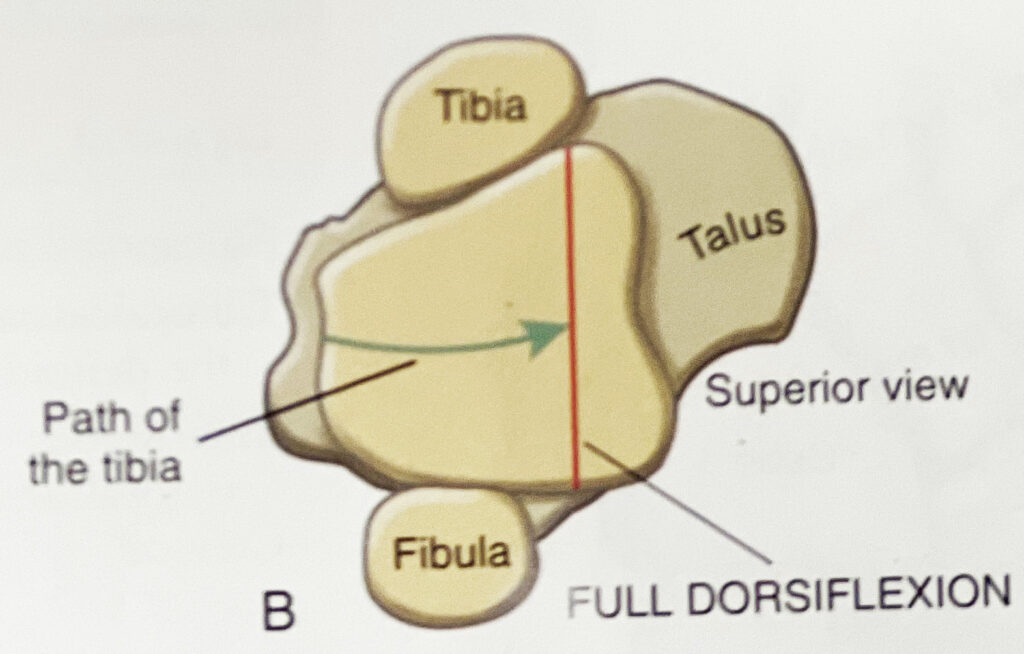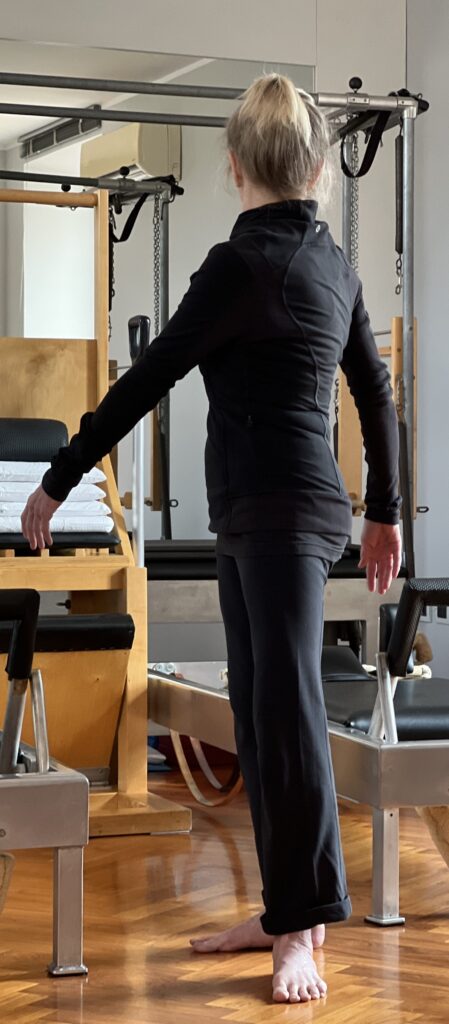What was Joe Pilates biggest pet peeve?
Hint: it’s on the Short Box
Making noise with the foot strap when doing the Short Box series would drive Joe mad. (He also hated chatting in the studio and labored breathing but that’s another post.)
If difficulty in dorsiflexion causes you to release the strap (and make noise), don’t automatically blame tight calf muscles.
Yes, these could be the culprit but limited dorsiflexion could also be the fault of bones. Specifically, the ankle bones.
Our shin has 2 long bones in it: the tibia and the fibula.
The tibia starts at the knee and ends in a flat shape which sits on top of the talus. The bony protrusion at the end of the tibia is called the medial malleolus, inner ankle bone. The fibula goes from the outside of the knee to the outside of the talus. Its bony end protrusion is called the lateral malleolus, outer ankle bone. The 2 malleoli encase the talus from both sides, like a carpenter’s mortise + tenon, forming the ankle (talocrural) joint.
The tibia and fibula are connected by the strong, resistant interosseous membrane. In the illustration below, the interosseous membrane is labeled syndesmosis. This is an anterior view of a right tibia + fibula. The protuberances at the ends of the bones are the malleoli.
 The talus is the oddest yet one of the most important bones in the body: it’s wider at the front, toward the toes, than in the back, toward the heel (illustration below).
The talus is the oddest yet one of the most important bones in the body: it’s wider at the front, toward the toes, than in the back, toward the heel (illustration below).
Donald A. Neumann
Kinesiology of the Musculoskeletal System
To dorsiflex, the lateral malleolus has to separate and lift a bit away from the talus to accommodate its wider front.
But if the interosseous membrane holding the tibia and fibula together is too tight, the lateral malleolus may get “stuck” impeding dorsiflexion.
Twisting the shin bones will move the foot in and out of supination and pronation. This will inadvertently loosen and limber the interosseous membrane allowing the lateral malleolus to widen and elevate sufficiently for dorsiflexion.
Test
- Sit on the floor with your right foot in front of you
- Please sit more comfortably than I am below!
- Gently place 2 fingertips on both malleoli
- Plantar (photo 1 below) and dorsiflex (photo 2 below) your ankle a few times noticing if the lateral malleolus “moves” a bit when doing this
- You should feel it widen laterally and elevate superiorly a tiny bit with dorsiflexion
- Note your ankle range of motion (ROM)
Prep
- Stand with hips, legs and feet parallel, hip-width apart
- Plant the left foot, all 4 corners, firmly on the ground
Action
- Swing the right leg and foot around and in front of the left toes pointing the right toes 90° relative to the left toes making an open letter “T” with the feet (photo 1 below)
- From here, swing the right leg and foot around and in back of the left heel, perpendicular to the heel, again making an open letter “T” with the feet (photo 2 below)
- Swing back and forth a few times
Re-Test
- Sit down again like before and re-test your ankle dorsiflexion
- This should make you smile!
- Keep all 4 corners of the planted foot firm to the ground
- If the big toe knuckle (1st metatarsal or 1st met head) lifts when swinging the opposite foot to the front, this won’t work
- If the outer border of the foot lifts when swinging the opposite foot to the back, this won’t work, either
- If the big toe knuckle (1st metatarsal or 1st met head) lifts when swinging the opposite foot to the front, this won’t work
- Allow your arms to swing!
- Allow the pelvis to rotate over the standing, planted leg!
- NOTICE WHAT HAPPENS UP THE CHAIN ➼ do you feel this in your glutes?
 Swinging the leg twists the shin bones of the planted leg causing supination + pronation to occur at the foot. As the leg swings forward, the tibia + fibula externally rotate taking the talus along for the ride and the foot supinates. As the leg swings back, these bones internally rotate taking the talus along for the ride and the foot pronates.
Swinging the leg twists the shin bones of the planted leg causing supination + pronation to occur at the foot. As the leg swings forward, the tibia + fibula externally rotate taking the talus along for the ride and the foot supinates. As the leg swings back, these bones internally rotate taking the talus along for the ride and the foot pronates.
The twist of the malleoli against the talus helps liberate the interosseous tissue between the shin bones which frees the ankle to dorsiflex.
With increased dorsiflexion ROM, you can more easily hold the foot strap firmly taut while doing the Short Box series, eliminate noise and pay homage to Joe.
PS Huge shout out to James Earls who went out of his way to make sure I understood this extraordinary exercise, and the science behind it, last weekend in Piacenza. Follow him! (Unassuming James is the tallest one in the back row.)
PSS Shout out to Christina Ferri at Studio 28 for hosting.












